
GORDON WILLIAMSON, illustrated by IAN PALMER
KRIEGSMARINE U-BOATS 1939-45
Many operational flotillas used a variety of different U-boat types through the course of the war, where others seemed to use a specific type predominantly, if not exclusively. The following flotillas are those in which use of the Type VII predominated:
1 Unterseebootsflotille - Types VIIB, VIIC and MID
3 Unterseebootsflotille - Types VIIB and VIIC
6 Unterseebootsflotille - Types VIIB and VIIC
7 Unterseebootsflotille - Various Type VIIs
9 Unterseebootsflotille - Types VIIC and VIID
11 Unterseebootsflotille - Type VIIC
13 Unterseebootsflotille - Type VIIC
14 Unterseebootsflotille - Type MIC
With just over 700 examples built, the Type VII was by far the most successful of all the U-boat types. It fitted well with the decision taken that Germany would build a large fleet of small- to medium-sized boats rather than a small fleet of large boats. Despite its modest size, and relative ease of construction, it proved itself a reliable design, capable of operating throughout the Atlantic, its capabilities restricted only by the amount of fuel/munitions it could carry.

A U-boat commander and his L.I. (Leitender Ingenieur) stroll along the foredeck of their "Type VIIC. The insulator blocks on the jump wires can be clearly seen. Note also the closed hatch for the ready-ammunition locker for the 8.8 cm deck gun just ahead of the commander.
The Type VII had a faster diving speed than the larger Type IX, a critical factor that endeared it to its crews, as did its capability of diving, on occasion, much deeper than its recommended safe maximum depth without mishap. The biggest 'downside' for the crews was the extremely cramped interior. Space was at an absolute premium and conditions within these boats could become extremely uncomfortable very quickly. However, to many U-boat men, even though the Type IX was more spacious and thus more comfortable, its slow diving speed and thus greater vulnerability when caught on the surface made the Type MI a relatively 'safer' boat.
Without doubt, the Type VII in its many guises was by far the most influential submarine in the U-boat war. Through the course of the war, over 2,600 war cruises were undertaken in the Type VII boats. During the course of these cruises, around 1,365 enemy ships were sunk, that total including 190 warships. From the total of just over 700 Type VIIs that were built, over 400 were sunk by enemy action. In the great majority of these cases, the boats were lost with all hands. Of the total of approximately 30,000 U-boat men who lost their lives in the Second World War, around 22,000, or 73 per cent, were serving on the Type VII.
The capabilities of the Type VII boat in the hands of an expert commander are easily established by a quick review of some of the most successful U-boat commanders of the Second World War, and the types of boats in which they operated.
On 17 September 1939, the Type VIIA U-29 under the command of Kapitänleutnant Otto Schuhart struck the first major blow against the Royal Navy when the aircraft carrier HMS Courageous was intercepted and sunk in the waters off the west coast of Ireland. Schuhart went on to accumulate of total of 12 enemy ships totalling some 83,700 tons before being given a shore command. He was decorated with the Knight's Cross and survived the war to serve in the West German Bundesmarine.
The first truly spectacular U-boat success of the Second World War, however, came on 14 October 1939 when Kapitänleutnant Gunther Prien succeeded in penetrating the fleet anchorage at Scapa Flow, and torpedoed and sank the battleship HMS Royal Oak. Although this warship was obsolete and its loss to the Royal Navy would have no major effect on the combat capabilities of the British fleet, the mere fact that a U-boat had penetrated what was considered to be a safe anchorage and sunk a major surface warship with considerable loss of life, and had then escaped unscathed, was a major progadanda disaster for Britain, and one which Germany exploited to the full. Coming hard on the heels of the sinking of the Courageous, it was a serious blow to the morale of the Royal Navy. Prien's entire crew was decorated with the Iron Cross and Prien himself with the Knight's Cross of the Iron Cross.
Prien's boat, the U-47, was an early Type VIIB that continued to serve him well. Prien quickly established that his success at Scapa Flow was no fluke as his score of tonnage sunk rapidly rose. Prien sank a total of 31 ships, some 192,000 tons, before U-47 was attacked and sunk by the destroyer HMS Wolverine on 8 March 1941. There were no survivors. Prien had added the Oakleaves to his Knight's Cross on 20 October 1940.
A contemporary of Prien, Kapitänleutnant Joachim Schepke, also commanded a Type VIIB, the U-100. Unlike Prien. there were no spectacular warship sinkings in his tally, but rather a steady and remorseless list of merchantman after merchantman sent to the bottom. He was decorated with the Knight's Cross of the Iron Cross on 24 September 1940 and added the Oakleaves on 20 December 1941. His boat was finally forced to the surface and rammed by the destroyer HMS Vanoc on 17 March 1941. Schepke was on the bridge at the time, and was crushed against the periscope mount by the impact and dragged down with the sinking U-boat At the time of his death he had sunk 37 ships totalling over 145,000 tons.
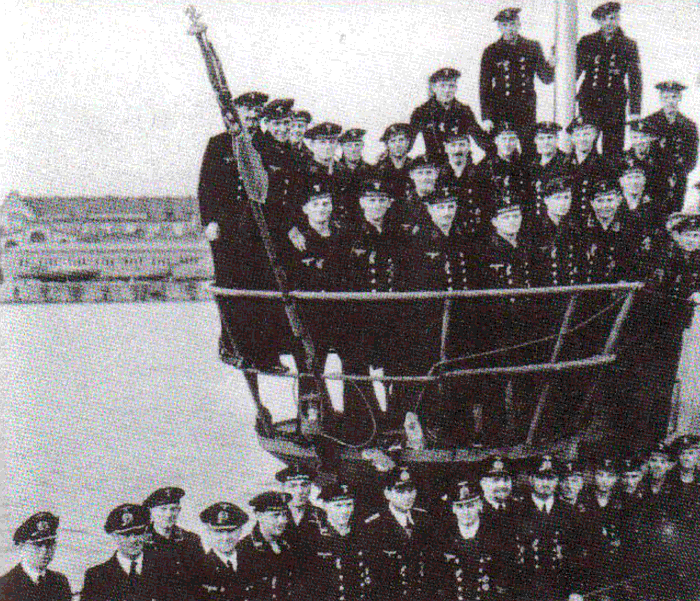
Though the rear flak platform on early Type VIICs looks relatively small, this photo of the assembled crew of U-46 shows just how many crewmen it could accommodate. U-boat crewmen rarely had the opportunity to wear their best blues. Photos such as this were usually taken on the day the boat was commissioned, or to celebrate a special event, as here, with the award of the Knight's Cross to the boat's captain, Kapitanleutnant Engelbert Endrass.
The third and by far the most successful of the Type VIIB 'aces' was Fregattenkapitän Otto Kretschmer. Kretschmer's quiet, serious demeanour earned him the nickname 'Silent Otto'. In command of U-99, however, his combat career was anything but 'quiet'. On his very first war cruise, Kretschmer sank eleven enemy ships. lie was awarded the Knight's Cross on 4 August 1940 and added the Oakleaves on 4 November of that same year. His score continued to rise, reaching 56 ships for a total of 313,600 tons sunk. Kretschmer finally met his match when he succumbed to a joint attack by the destroyers Vanoc and Walker on 17 March 1941, in the same convoy battle in which Schepke was killed. Fortunately, the majority of U-99's crew, including Kretschmer himself, were able to abandon their stricken U-boat safely and spent the remainder of the war in a POW camp. Whilst in captivity Kretschmer learned that he had been decorated with the Swords to his Knight's Cross with Oakleaves on 26 December 1941. Kretschmer's total tonnage sunk, which was never surpassed, made him the highest-scoring U-boat ace of the Second World War. This highly respected sailor survived the war and, when the German Navy was re-formed, returned to the sendee and eventually retired with the rank of Flotillenadmiral.
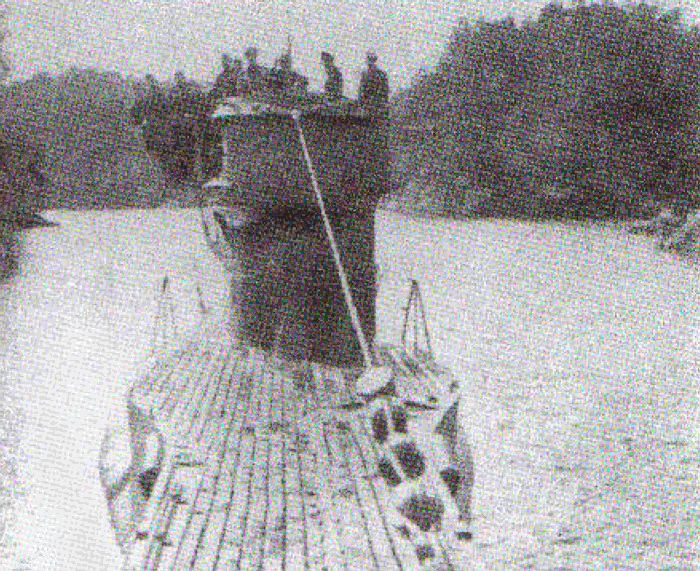
A view from the bows of the same late-war Type VIIC as in the previous photograph. Note the lack of deck gun in Type VIIs from the second half of the war, the emphasis thereafter being on anti-aircraft armament. Unusually, this boat seems to be moving along some narrow inland waterway.
Amongst those who achieved great success with the Type VIIC, there are two main types of ace, the tonnage aces and the warship killers. One of the most famed Type VIICs is undoubtedly U-96, the subject of the acclaimed movie Das Boot. Whilst the film is based on a real boat, the account is fictionalised and not altogether accurate. In the film, the boat's commander dies, but in reality the factual commander, Fregattenkapitän Heinrich Lehmann-Willenbrock, went on to even greater success and survived the war. Like the fictional captain, Lehmann-Willenbrock was decorated with the Knight's Cross of the Iron Cross, receiving his award on 26 February 1941. Lehmann-Willenbrock also received the Oakleaves, on 31 December 1941, and went on to sink a total of 25 enemy ships, for a total tonnage of 183,000 before moving to a shore posting, in command of first the 9th then the 11th U-boat Flotillas.
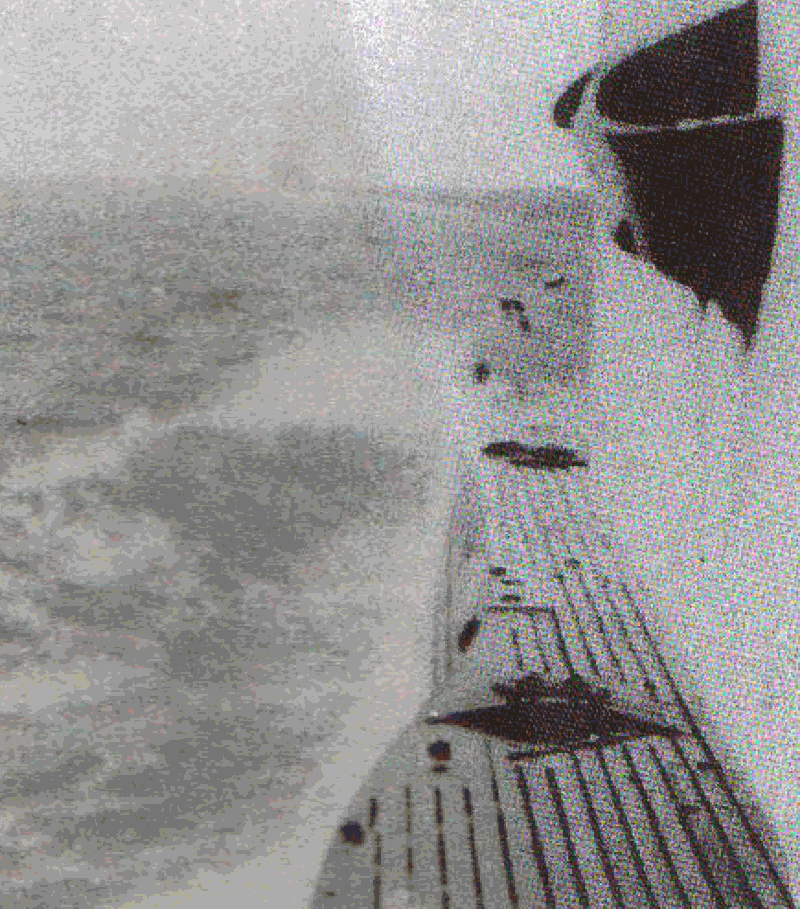
A Type VIIC on training exercises in the Baltic. Note how narrow is the width of deck available for passing along the side of the tower. The Type IX was, by comparison, far more spacious.
The list of highly successful tonnage aces included Korvettenkapitän Adalbert Schnee, who sank a total of 24 enemy ships totalling 88,995 tons with his Type MIC U-boat, U-201. Schnee was awarded the Knight's Cross on 30 August 1941 and the Oakleaves on 15 July 1942. Schnee (whose name in German means 'snow') was known for the emblem of a snowman on the conning tower of his boat. He was one of the first to be given command of one of the new Type XX U-boats (U-2511). Although lie only put to sea on his first operational cruise in the closing days of the war, and was unable to achieve any contact with the enemy before the order to cease hostilities was transmitted, he did carry out a successful dummy attack run on a group of British warships and escaped totally undetected.
Another of the great Type VIIC tonnage aces was Fregattenkapitän Erich Topp, whose conning tower emblem of a prancing devil painted in red earned U-552 the nickname of the 'Red Devil Boat'. Topp was decorated with the Knight's Cross on 20 June 1941, the Oakleaves on 11 April 1942 and the Swords on 17 August 1942. His eventual total of enemy ships sunk was 35, for a total of 192,600 tons. Amongst his kills was the destroyer USS Reuben James. Like Schnee, Erich Topp was given command of one of the latest Type XXI boats in the closing stages of the war. Schnee also joined the re-formed German Navy after the war and eventually retired with the rank of Konteradmiral. In 2000, this highly respected sailor, who over the years had made innumerable historians and researchers welcome to his home, was dismayed to discover that one 'guest' had stolen many of his decorations as well as his bejewelled naval Honour Dagger.
Several of the great Type VIIC aces earned their Knight's Cross, not by sinking huge tonnages of enemy merchant ships, but by spectacular sinkings of major enemy warships. Amongst these was Kapitänleutnant Hans Diedrich von Tiesenhausen, commander of U-331. Although this commander, operating in the Mediterranean sank but two ships, his total tonnage score was 40,435. The reason for the high tonnage with just two ships was that one of these was the battleship HMS Barham, torpedoed and sunk by von Tiesenhausen on 25 November 1941. His other sinking was a 9,000-ton freighter, the Leeds town. He was awarded the Knight's Cross for his sinking of the Barham on 27 January 1942. On 17 November 1942, U-331 was attacked and sunk by Swordfish torpedo bombers from the aircraft carrier HMS Formidable. Von Tiesenhausen and 15 of his crew were rescued and spent the remainder of the war in captivity.
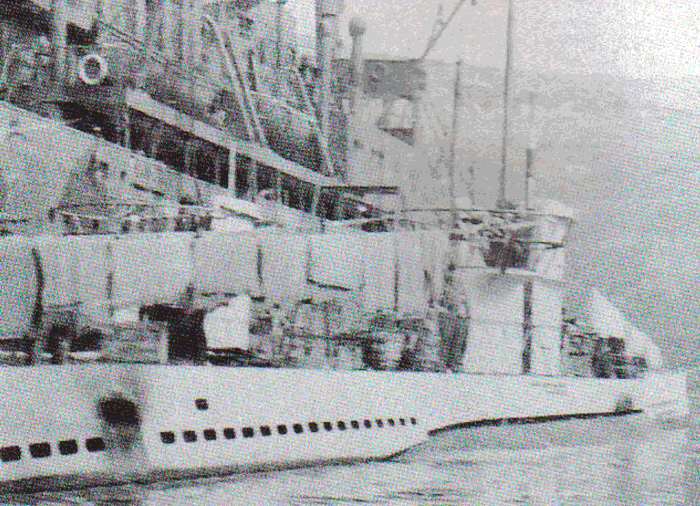
A Type VIIC moored alongside her tender. The crew has taken the opportunity to hang out all their blankets, damp from the boat's interior conditions after a war cruise, to air and dry. Obvious here also is the dark grey finish to the saddle tanks, in contrast to the lighter grey of the hull.
Other warship killers included Kapitänleutnant Klaus Bargsten, commander of U-521, whose sinkings, though totalling only six ships, included the famous Tribal class destroyer HMS Cossack and the US sub-chaser Bredon, and Korvettenkapitän Helmut Rosenbaum, commander of U-753, whose similar total of six ships sunk included the aircraft carrier HMS Eagle.
A Type VII U-boat was also responsible for sinking one of the Royal Navy's most famous ships, the aircraft carrier HMS Ark Royal. On 13 November 1941, the 26-year-old Kapitänleutnant Friedrich Guggenberger, having just reached the Mediterranean in command of U-81, torpedoed the Ark just 25 miles from Gibraltar. It was a propaganda triumph for Germany, which had in fact been prematurely claiming the sinking of the Ark Royal for some time, and a disaster for the Royal Navy, especially in light of the result of subsequent enquiries, which established that she might have been saved had she not been prematurely abandoned.
One of the most interesting of U-boat commanders was Korvettenkapitän Peter Erich 'Ali' Cremer. Cremer was decorated with the Knight's Gross of the Iron Gross on 5 June 1942 as commander of the Type VII U-333, the boat's first commander having served previously on the destroyer Theodor Riedel Cremer sank a modest seven enemy ships totalling some 36,000 tons, and was eventually given a shore posting where he commanded the 'Wachbattailon Dönitz'. Thrown into combat around Hamburg in the last few days of the war, Cremer led a highly successful 'tank-hunting' unit that knocked out a significant number of British tanks during the defensive battles around the port.
Not all of the most highly decorated Type VII aces were tonnage or warship killers. Only two men in the entire Kriegsmarine were decorated with the coveted Oakleaves, Swords and Diamonds to the Knight's Gross. One, Wolfgang Lütli, was a Type IX commander, and the other, Albrecht Brandi, commanded a Type VII.
Albrecht Brandi had begun his naval career with the minesweeping branch and only came to the U-Bootwaffe in April 1941. Having completed his conversion training, he took command of U-617 in September 1942. On his first war cruise he sank four ships totalling 15,163 tons. On his next war cruise, Brandi entered the Mediterranean, where he made attacks on a destroyer, a cruiser and a battleship, but without success. His next cruise saw him sink a seagoing naval tug and damage a destroyer before sinking two medium-sized freighters. On 21 January 1943, he was decorated with the Knight's Cross of the Iron Cross. On Brandi's fourth war cruise, he sank the minelayer HMS
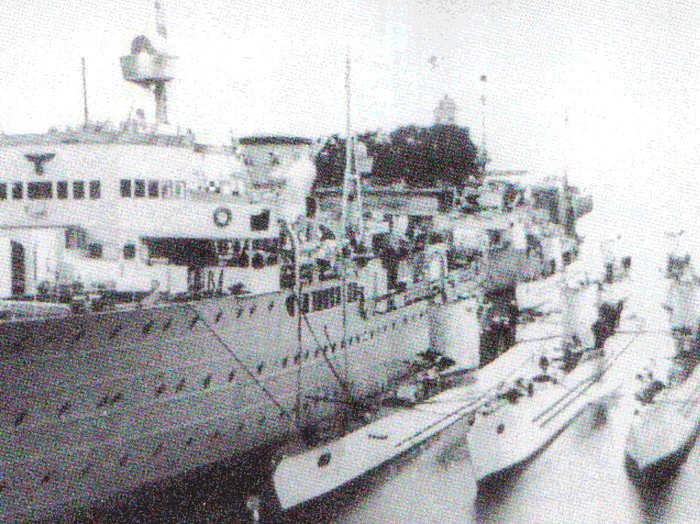
The U-boat escort/tender Saar. Moored alongside, next to the Saar, is a Type IA and, outboard of this boat, two Type VIIAs. The dark grey decking, contrasting with the light grey hull, is clearly seen. Note that all three boats have had the net cutters removed.
Welshman and two merchant ships. His fifth cruise saw U-617 attacking a British cruiser and two destroyers. Hits were claimed, but it has not been possible to verify these. Brandi was awarded the Oakleaves on 11 April 1943. On his eighth war cruise, Branch attacked and sank the destroyer Puckeridge and also claimed the sinking of two unidentified warships. U-617 was herself attacked on 11 August 1943 and severely damaged by British aircraft. Pursued by British warships, she entered Spanish territorial waters and beached herself near Sidi Amar in Spanish Morocco. The crew was initially interned but eventually repatriated to Germany.
Brandi was given command of another Type VIIC, U-967, in March 1944. This boat operated briefly in the North Atlantic before being transferred to the Mediterranean in January 1944. Here Brandi once again attacked a number of warships, sinking the destroyer escort USS Feehteler on 4 May 1944. Brandi was decorated with the Swords on 9 May 1944. Whilst still in command of U-967, Brandi received the Oakleaves, Swords and Diamonds on 24 November 1944. He was subsequently posted to command the Kleinkampfmittelverbände (midget submarines, one man torpedoes and other special weapons) and survived the war. He did not re-enter the post-war navy and died in retirement in Dortmund in 1966.
Brandi is a prime example of a U-boat captain whose actual, verified sinkings are rather modest in terms of tonnage sunk, yet who received the highest military decorations. What becomes rapidly apparent about Brandies record is his fearless aggression in attacking enemy warships. The substantial British Navy presence in the Mediterranean, the tight control exercised over the Straits of Gibraltar and the relatively shallow nature of these waters, giving the U-boats less chance to manoeuvre, made operating here much more dangerous than in any other waters. Despite this, Brandi rarely let the opportunity to attack enemy warships pass, and in a time when U-boat losses were escalating rapidly such determination to take the battle to the enemy was highly valued by Grossadmiral Dönitz.
Fortunately, several of the great U-boat aces of the Second World War survived the conflict and many of those have committed their memoirs to print. In the case of those who did not survive, many have had scholarly biographical studies written about them. For those who wish to read further into what life was like on the Type VII U-boat during this momentous period in history, there is a rich vein of material available.
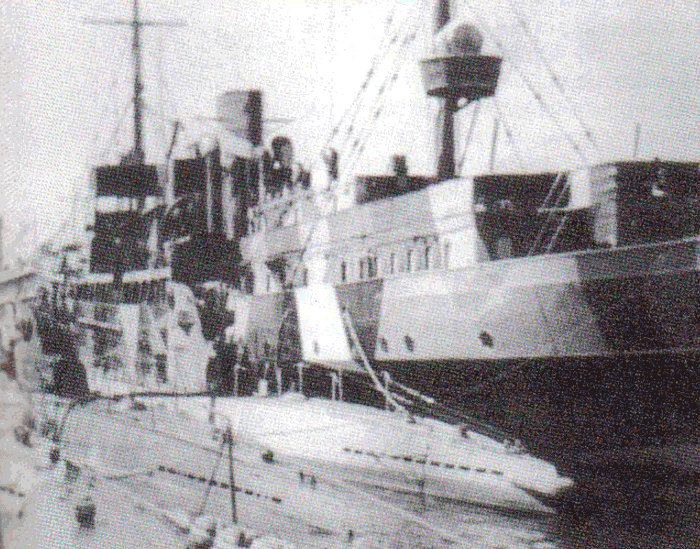
Most photographs of Type II submarines show them in their pre-war pale grey livery. This wartime shot shows a Type IIA and a Type IIB vessel, both tied up alongside their tender. Note the wartime splinter-type disruptive camouflage applied to the tender and the darker grey livery of the Type IIA nearest the camera. The Type IIB seems still to retain its lighter grey colour. By this time, both would most likely have been reserved for training duties.
We have much more interesting information on this site.
Click MENU to check it out!
∎ cartalana.com© 2009-2025 ∎ mailto: cartalana@cartalana.com